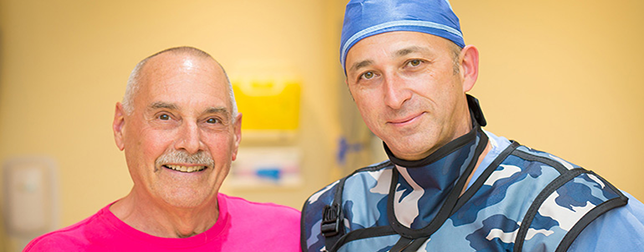Jay Derrig, a 63 year old social worker and counselor, is afflicted with meralgia paresthetica in his right leg. Meralgia paresthetica is compression of the nerve that supplies sensation to the skin surface of your thigh. It is a condition characterized by tingling, numbness and burning pain in your outer thigh. Jay had been suffering from this for over 16 years and had seen multiple doctors for it to no avail.
“It was constant, and really quite intense to the point where sometimes I felt like I was going to fall, because I felt like I didn’t have any muscle, because there was so much pain,” Jay said.
Lucky for him, Health Canada approved a new solution earlier this year: a peripheral nerve stimulator called the Bioness StimRouter. This minimally invasive neuromodulation device has an implanted lead, an external pulse generator, and a hand-held wireless programmer. The wearable device uses programmed electrical pulses to stimulate an erratic peripheral nerve and retrains the brain to perceive sensations as non-painful.
Read more This “Smart Stent” Can Monitor Blood Flow and Detect Narrowing of Artery
Two weeks ago, Dr. Michael Gofeld, MD, PhD, FRCPC, a Chronic Pain Management physician at the Silver Centre for Pain Care in North York, Ontario, and an Associate Professor at the University of Toronto, implanted the first StimRouter into Jay.
For Jay’s procedure, Dr. Gofeld inserted the StimRouter’s guide lead through a stab incision in Jay’s hip area and positioned it to the target nerve using ultrasound guidance.
Jay gave feedback to Dr. Gofeld when he felt the stimulation in the right place. Dr. Gofeld then held the guide’s location, replaced it with the permanent lead, and locked it in place. It then became ready to be activated using the external pulse generator.

The length of the procedure was short – only 34 minutes, although, Dr. Gofeld completed the same procedure in his second patient in just 17 minutes. The procedure left only a pimple-sized scar on Jay’s hip.
After the procedure, Jay was fitted with personalized programs for the external pulse generator that changed the amplitude, frequency, and pulse width of the therapeutic signal, giving him full control throughout the day to choose a program to suit his pain needs. He’s been using the device on a 4-hours on, 15-minutes off cycle so far. Some patients said as time went on, they relied on the device less and less, and some even reported completely eliminating the need for it. This is thought to be due to sensory nerve rewiring in the brain from the stimulation leading to a permanent alteration in the way the brain perceives the pain.
Read more New Smart Socks Help Prevent Patient Falls
Jay’s wife, Bev, was thankful for his recovery. “He got the quality of his life back, which is important to us because we travel an enormous amount, and we go to the gym every day, and we’re very, very active. He was losing more and more of it because he couldn’t keep up. Now he can kayak as long as I can go and bike 22 kilometers in the morning and he doesn’t have to get off because his leg is bothering – he can do it all. Mentally, it really stimulated him a great deal because it gave him back his quality of life. Now he feels so happy.”
“14 and a half years, and we’ve never had a quarrel. No words, not ever,” she smiled.
Of course, Jay elaborated with his typical banter. “Actually, we just don’t talk to each other!”












